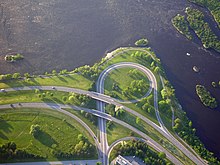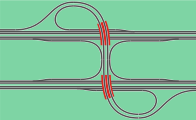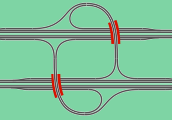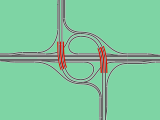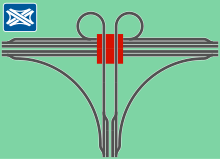Autobahn triangle

A motorway triangle is a three-armed, elevation-free traffic junction at which one motorway joins another.
In terms of road traffic law, the term Autobahn triangle only exists in Germany (symbol ![]() , short name: AD). In the GDR and the German Reich, a triangle was called a branch . Neither in Switzerland nor in Austria , there is no distinction between triangles and crosses: In Switzerland these are referred to as motorway junctions (symbol:)
, short name: AD). In the GDR and the German Reich, a triangle was called a branch . Neither in Switzerland nor in Austria , there is no distinction between triangles and crosses: In Switzerland these are referred to as motorway junctions (symbol:) ![]() , in Austria as nodes. When the symbols for intersections were introduced on the motorway signs, no distinction was made between cross and triangle in Germany either.
, in Austria as nodes. When the symbols for intersections were introduced on the motorway signs, no distinction was made between cross and triangle in Germany either.
If there is no connection between two of these arms, one speaks of a motorway fork . In Germany, it used to be called "Autobahn junction", where this term is more appropriate and is still the correct technical term there.
Motorway triangles are located where one motorway ends and joins another or where its course is interrupted. In the latter case, it is indeed a triangle, but here mostly, at least in part, a motorway junction is built and the junction is already referred to as a motorway junction. This means that if the motorway continues to be built, it can be put into operation without major structural effort and without renaming.
Components
The components of a motorway triangle essentially correspond to those of a motorway junction .
Designs
There are three basic forms of motorway triangles, as well as one that corresponds to an unfinished motorway junction. All forms have advantages and disadvantages in terms of economy, traffic volume, space requirements and safety.
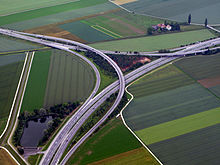
triangle
With this design, all left-turning lanes are guided semi-directly in a large radius. This enables high speeds. There are two variations of this triangle, depending on the intersection of the ramps: with three individual throws in two floors or with two throws in three floors, which is also known as a half Maltese cross .
The use of this design is particularly useful where there is high traffic density in all directions. In Germany, it is mainly to be found in areas with heavy traffic. In Austria it is the most frequently used shape, in the USA it is very common and the design common on highways in metropolitan areas.
- Examples of this design in Germany
- Hattenbacher Dreieck ( 50 ° 48 ′ 19 ″ N , 9 ° 31 ′ 50 ″ E ) - A very large shape with three bridges on the A 7 / A 5 . Contrary to what the numbering of the motorways suggests, the relation Frankfurt am Main - Kassel (A 5 – A 7) describes the continuous carriageway.
- Viernheimer Dreieck ( 49 ° 33 ′ 21 ″ N , 8 ° 33 ′ 24 ″ E ) - Very symmetrical triangle with three bridges on the A 6 / A 67 . The continuous carriageway forms the route Frankfurt am Main - Karlsruhe (A 6 – A 67).
- Karlsruhe motorway triangle on the A 5 / A 8 .
- Autobahn triangle Würzburg-West ( 49 ° 44 ′ 42 ″ N , 9 ° 49 ′ 11 ″ E ) - design with only one bridge structure on the A 3 / A 81 . Today's triangle was planned as a Maltese cross .
- Motorway triangle Frankfurt-Erlenbruch ( 50 ° 7 ′ 50 ″ N , 8 ° 43 ′ 30 ″ E ) - Very symmetrical design with trough structures on the A 661 / A 66 . This triangle is being built in the east of Frankfurt am Main as part of the Riederwald tunnel construction project .
- Examples of this design in Germany with almost no bridge
- Rosa-Luxemburg-Strasse , Marie-Curie-Strasse ( 50 ° 10 ′ 6 ″ N , 8 ° 37 ′ 46 ″ E ). The only bridge is the Rosa-Luxemburg-Straße, which is to be expanded to four lanes in a north-south direction.
- Example of this design in Austria
- Innsbruck junction ( 47 ° 14 ′ 58 ″ N , 11 ° 23 ′ 54 ″ E ) - At this triangle with three bridges, the A13 Brenner motorway joins the A12 Inntal motorway. The continuous relation is formed by the A13 and the eastern part of the A12.
- Examples of this design in other countries
- Échangeur de Tournai ( 50 ° 37 ′ 48 ″ N , 3 ° 25 ′ 11 ″ E ) - Very elaborate shape of a motorway triangle on the A8 / A16 near Tournai in Belgium . The fully developed Tournai junction, which consists of a total of seven ramps , is located within the triangle .
- Before Qingdao in the People's Republic of China is a triangle as part of the middle of the bay of Jiaozhou Qingdao Haiwan bridge installed and is at 36 ° 10 '12 " N , 120 ° 17' 54" O .
- Motorway triangle between the Autoroute A6 and the Autoroute A31 near Beaune in France.
- Motorway triangle between the Autoroute A40 and the Autoroute A42 near Pont-d'Ain in France.
Triangle without a single main direction
In the guidelines for the construction of motorways (RAA) a "triangle without a uniform definition of the main carriageway" is defined. This is a height-free, three-armed traffic junction, which consists of three forks , whose respective overpass structure only crosses one lane in the opposite direction, creating a TOTSO or a left-hand exit opposite the branching road in the main direction . Gaps are created between the directional lanes. The design is available several times in the USA. One example in Germany until 2007 was the junction on the yellow B7 motorway (Brussels street) to Düsseldorfer Straße in the west of the Oberkassel district of Düsseldorf . 51 ° 14 ′ 3 ″ N , 6 ° 43 ′ 57 ″ E
Trumpet
With the so-called “trumpet”, one lane turning left is guided semi-directly and one indirectly. This design is inexpensive because only one bridge structure is necessary and relatively little area is required. However, the maximum speed in the indirectly guided connection ramp is low. Because of its simple design, the trumpet is also suitable as a motorway junction if the feeder ends at the junction. The free-flowing traffic due to the freedom of height does not entail any additional costs for the bridge structure, as there is no interconnection.
There are two variants of the trumpet: the right-hand and the left-hand one. The trumpet is often to be found in Germany, but the right-hand one is less common, as the traffic has to be guided into the narrow radius of the loop without an upstream delay lane, which has a negative effect on road safety. Therefore, this design is preferably only implemented if the space available does not allow any other design.
Examples of the trumpet design in Germany :
- Kirchheimer Dreieck ( A 7 / A 4 ) - left
- Motorway triangle Fulda ( A 7 / A 66 ) - left
- Motorway triangle Düsseldorf-Süd ( A 46 / A 59 ) - turned right
- Motorway triangle North Harz ( A 36 / A 369 ) - left
- Autobahn triangle Halle-Süd ( A 38 / A 143 ) - left
- Inntal motorway triangle ( A 8 / A 93 ) - left
- Saarlouis motorway triangle ( A 8 / A 620 ) - turn right
- Autobahn triangle Oldenburg-West ( A 28 / A 293 ) - turn right
- Autobahn triangle Südharz ( A 38 / A 71 ) - turn right
- Motorway triangle Werntal ( A 71 / A 70 ) - turn right
- Freeway triangle Friedrichsthal ( A 8 / A 623 ) - turn right
- Motorway triangle Drammetal ( A 7 / A 38 ) - turn right
- Treptow motorway triangle ( A 117 / B 96a ) - turn right
A trumpet in the water is north on Taipa ( Macau ) on the Estrada Alm. Magalhaes Correia to Pte. da Amizade to find the bridge to the airport. 22 ° 9 ′ 56 " N , 113 ° 33 ′ 50" E
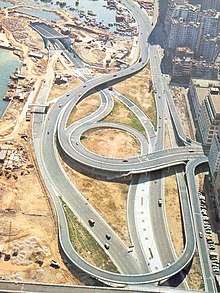
22 ° 16 ′ 52 ″ N , 114 ° 10 ′ 49 ″ E
Melted trumpet
In the case of the melted-down trumpet, in contrast to the trumpet, the continuous direction of travel is spatially separated from the flowing traffic route in order to connect the flowing traffic by interlacing. This creates connections on the left (when driving on the right ). After a turning loop, the opposite direction is again linked by interlacing. The interconnections lie outside of the bridge structure and are the only capacity limit for a single-lane design. This design requires the smallest bridge area, but more space. Only one lane needs to be bridged by another. Technically, this is an internally fed, disentangled, teardrop-shaped turbo roundabout that does not interrupt the main directions, or a motorway fork without a main direction with a subsequent left-hand turning loop, which saves additional expensive space within the overpass. The turning loop is similar to the Michigan Left . Another approach to the description is the expansion of a fork into a triangle by spatial separation of the directional lanes. In the west of the US state of Texas, Interstate 20 ends at Interstate 10 at 31 ° 5 ′ 25 ″ N , 104 ° 3 ′ 9 ″ W in this design. There are several transport hubs of this type in Florida .

Double trumpet
Two trumpets are used when two motorways or motorway-like roads come very close, but do not cross each other or only cross at another point, or when a connection is subsequently created. In this case, a short motorway-like connection piece is inserted, creating two three-armed nodes (trumpets). In this case, the mouthpieces of the trumpets are directly connected to each other. Opposite a cross, the two T-pieces form an H-shaped connection with 4 arms. This is preferred in Italy, Japan and the USA to connect toll roads with toll-free roads. The vehicles are mixed according to their destination, but sorted by entering and exiting the toll road. Examples of double trumpets are:
- The Gießener Nordkreuz consists of two left-hand trumpets.
- The connection between the A 45 at Dillenburg and B 277 at 50 ° 44 '38 " N , 8 ° 15' 37" O .
- The Trier-Ehrang junction, which connects the A 602 with the B 52 at 49 ° 48 ′ 7 ″ N , 6 ° 42 ′ 31 ″ E.
A special form of the double trumpet with no direct ramps is the paper clip . The indirect trumpet is related .
There are also double trumpets whose funnels lead onto the same motorway. This could be the design for a motorway junction, if the exit ramp of a branching motorway can be attached to the left or two motorways end at the continuous one. Since the ears lie one inside the other with two directions of travel, considerable space is saved.
- In the Norwegian place Bergen one of kompaktesten double trumpets connects the E39 and the E18-ending, the Fjøsangerveien and Sotraveien (Highway 555) at 60 ° 23 '1.1 " N , 5 ° 20' 9.4" O .
- A double trumpet is the Järnbrott junction (Järnbrottsmotet), which is in the south of Gothenburg at 57 ° 38 ′ 45.5 ″ N , 11 ° 55 ′ 51.4 ″ E and the highway 158 with the Dag-Hammarskjöld motorway on the site connects the two bridges of the Europa-Kreisel, which existed until the 1990s. This is made possible by two intermediate ramps.
- In South Carolina at Myrtle Beach cross 10km to the Atlantic coast of the United States 501 and the Carolina Parkway, the SR-31 at 33 ° 44 '26 " N , 78 ° 57' 6.4" W .
- In Vermont, north of Bennington, at 42 ° 54 ′ 15.3 ″ N , 73 ° 12 ′ 15 ″ W , a "fused" double trumpet is created with two ramps shortened by the design; a powerful node that connects the US-7 to the VT-SR-279.
- The space-saving node is represented twice in Singapore : between the Bukit Timah and Seletar expressways at 1 ° 25 ′ 17.1 ″ N , 103 ° 46 ′ 16.9 ″ E and at 1 ° 19 ′ 31.5 ″ N , 103 ° 58 ′ 20.4 ″ E on East Coast Parkway to Changi Coast Road and Xilin Avenue.
- A similar construction is the Moseltal motorway triangle , which consists of two right-hand trumpets and, depending on the location, also requires two indirect ramps to connect the L145 via the L150 in all directions.
- A double trumpet was the junction Telegraph Road (part of US-24 ) to Interstate 94 in Taylor , located south in the greater Detroit area in the US state of Michigan at 42 ° 15 ′ 52.9 ″ N , 83 ° 16 for around 50 years '13.5 " W . The junction, which was dismantled to SPUI in 2005 , lost its free flow of traffic at the cost of moving the exits to the right-hand side of the interstate. In the course of this, the directional lanes of the interstate were brought closer together.
pear
In the case of a pear-shaped motorway triangle, the counterpart to the turbine , both lanes turning left are guided semi-directly. This makes it possible to drive through at high speed, but also requires more space than the trumpet, and two bridges are necessary.
This type of construction is rarely found in Germany, as it has no major advantages over the other variants in terms of costs or space requirements. As a pear was z. B. the motorway triangle Braunschweig-Südwest ( A 39 / A 391 ) built until 2011. The new shape of the triangle is also based on the pear. The Bochum-West motorway triangle, which opened in June 2015, is also based on the shape of the pear, but here one of the semi-direct ramps is located outside the direct ramps.
Half leaf clover

The half clover (also part of clover , Switzerland eye ) is a special case under the highway triangles. It is only present when an expansion is planned motorway junction as clover already in construction. The entire state of development is normally designed in such a way that an extension to a complete motorway junction is possible without having to convert the existing structures. Most of the time, only those direct and indirect connection ramps that are actually used are completed. The central bridge structure, however, is fully expanded. Opposite the trumpet, the half-leaf clover has an interwoven stretch .
There are many examples of this design in Germany . They are a clear indication of the planned - and partly rejected - continuation of the motorways. In contrast to other variants of motorway triangles, they usually already have the name motorway intersection:
- Holledau motorway triangle ( A 9 / A 93 )
- Motorway junction Dortmund / Witten ( A 44 / A 45 )
- Triangle wages ( A 30 / B 61 )
Web links
- Ágnes Lindenbach: Plan-free nodes. (PDF; 410 kB) Lecture 2, Roads and Railways II. BMEEOUV-N40. Budapest University of Technology and Economics, pp. 2–5 , archived from the original on July 5, 2015 ; accessed on March 15, 2017 .
- Adolf Elsaesser: Cities on the Hafraba Roads. (PDF; 1.5 MB) III. Mannheim. In: Hafraba-Mitteilungsblatt. 1930, accessed on March 15, 2017 (article from 1930 on the intersection-free turnaround Mannheim and Heidelberg).
- Motorway junctions and triangles in Germany (database with map and aerial photo data). ( Memento from March 30, 2016 in the Internet Archive ) (in archive.org)
Individual evidence
- ↑ Motorway junction: RAS 1968 (FRG) RIST 1990 (GDR) Neufert (1937, 1980, 1996).
- ↑ Guidelines for the construction of roads. Part: Walter Durth (Ed.): Lines. RAS-L. Research Society for Roads and Transportation, Cologne 1995, ISBN 3-7812-1400-1 .
- ^ Institute for Roads and Railways at KIT: Design and Construction of Roads - Part: Road Design. (PDF; 8.44 MB). Retrieved September 7, 2013.
- ^ Günter Wolf: Street planning . Werner Verlag, Munich 2005, ISBN 3-8041-5003-9 , pp. 269 .
- ^ Joseph E. Hummer: Introduction to and Update on Unconventional Interchanges. ( December 16, 2014 memento on the Internet Archive ) Regional Transportation Alliance, Raleigh, NC, accessed June 27, 2014, p. 43.
- ^ Historical aerial photo in the Museum of Ridiculous Highway Design. Retrieved March 28, 2013.
- ↑ Swiss Norm 640 250 knots; Basic standard , 1998 edition, p. 7
Remarks
- Google Earth has aerial imagery on the subject. Historical aerial photographs are not available in the mobile version and the Earth plug-in of Google Maps .




